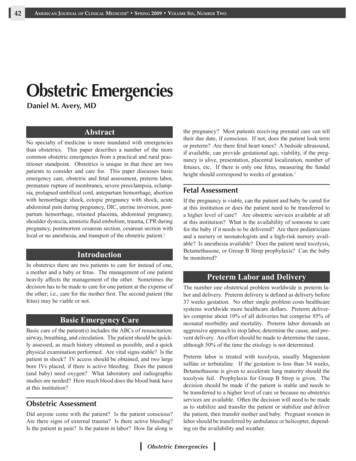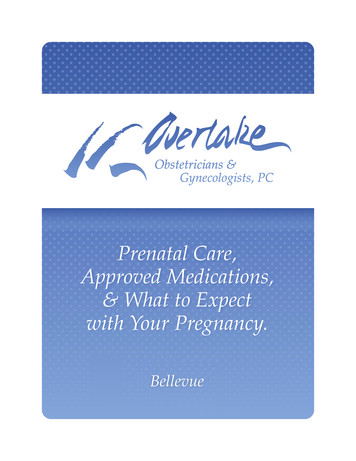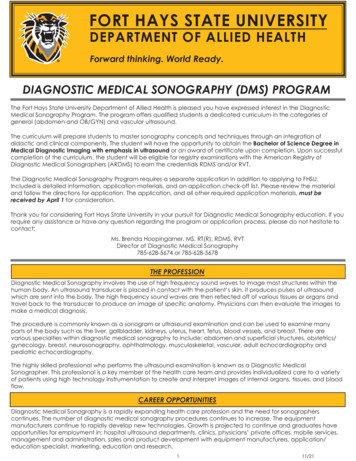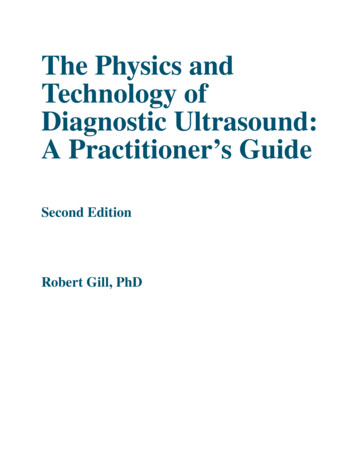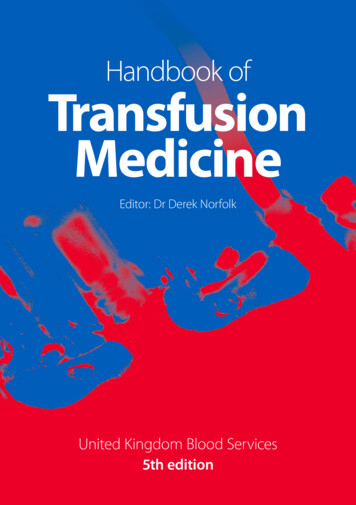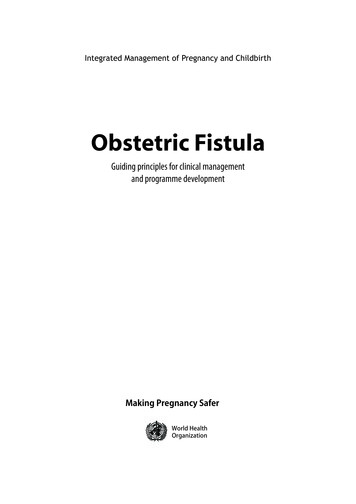
Transcription
Obstetric FistulaGuiding principles for clinical managementand programme developmentMaking Pregnancy SaferWorld HealthOrganization
ContentsAkcnowledgementPrefaceSection Iiiivvii1 Introduction12 Principles for the development of a nationalor sub- national strategy for the protection and treatment7Annex A: Recommendationss on training from theNiamey meetingAnnex B: Recommendations on monitoring and evaluation ofprogrammes from the Niamey meeting (2005)2225Section II273 Clinical and surgical principles for the management andrepair of obstetric fistula29Annex C: The classification of obstetric fistula374 Principles of nursing care39Annex D: Patient card455 Principles for pre and post operative physiotherapy476 Principles for hte social reintegration and rehabilitationof women wh have had an obstetric fistula repair53
IIIAcknowledgmentsEditors: Gwyneth Lewis, Luc de Bernis,Fistula Manual Steering Committee established by the International Fistulaworking group: Andre De Clercq, Charlotte Gardiner, Ogbaselassie Gebreamlak, Jonathan Kashima, John Kelly, Ruth Kennedy, Barbara E. Kwast, PejuOlukoya, Doyin Oluwole, Naren Patel, Joseph Ruminjo, Petra Ten Hoope,We are grateful to the following people for their advice and help with specificchapters of this manual:Chapter 1: Glen Mola, Charles VangeenderhuysenChapter 2: Maggie Bangser, Adrian Brown, Yvonne WettsteinChapter 3: Fistula Surgeons: Andrew Browning, Ludovic Falandry, John Kelly,Tom Raassen, Kees Waaldijk, Ann Ward, Charles-Henry Rochat, Baye AssaneDiagne, Shershah Syed, Michael Breen, Lucien Djangnikpo, Brian Hancock,Abdulrasheed Yusuf, OuattaraChapter 4: Ruth KennedyChapter 5: Lesley CochraneChapter 6: Maggie Bangser, Yvonne WettsteinAdditional thanks are due to:France Donnay, Kate Ramsey, Claude Dumurgier, Rita Kabra, Zafarullah Gill.Barbara E. Kwast and Meena Cherian
IV
VFistula ManualPrefaceThis brief manual on Fistula prevention and management is part of the International Campaignto End Fistula. The Campaign began in 2002 with the goal of drawing attention to obstetricfistula both as a medical issue and in its social and economic dimensions in those countrieswhere it is a significant problem. The long-term goal is to make fistula as rare a problem in theseareas as it is in developed countries today.The campaign is sponsored by UNFPA in cooperation with WHO, the International Federationof Obstetrics and Gynaecology (FIGO), the Averting Maternal Death and Disability (AMDD)Program at Columbia University, EngenderHealth, the Women’s Dignity Project (Tanzania), andother nongovernmental organizations.The purpose of this short manual is three-fold. Firstly it aims to draw attention to the urgentissue of obstetric fistula and to act as an advocacy document for change. The second objectiveis to provide policy makers and health professionals with both a short factual backgroundbrief and provide the principles for developing a national or regional fistula prevention andtreatment strategy and programme. The third aim is to assist health care professionals in betterdeveloping their services and skills when caring for women who are undergoing treatment forfistula repair.It can thus be read and used at many different levels by many different people, all of whom havethe possibility of making changes that will turn despair into hope and restore dignity to the livesof the millions of women living in shame and poverty.It was jointly written by key members of the Campaign and fistula experts, representingmany partner organizations, with the technical and financial support of WHO. UNFPA,EngenderHealth and the Women’s Dignity Project kindly allowed some short summaries ofexisting publications to be included here. Its publication was supported by AMDD.WHO Family and Community Health Cluster and Making Pregnancy Safer Department hopethat this document will help building a world on which women will be respected and will be ableto fulfil their rights to health.Joy PhumaphiFCH ADGWHO Geneva
VIISection IUnderstanding the problem anddeveloping a national approach
VIIITerefa’s storyTerefa is fourteen years old. She lives in a small village in Africa, more than 200km from thecountry’s capital. She is the sixth child in a family of eight children and has never been toschool. Her father, a farmer, did not have enough money to send all of his children to the villageschool. The older children – two boys – thus benefited from schooling, while Terefa stayed athome to help her parents to survive. Her chores were to gather firewood, draw water, and helpwork the fieldsWhen she was thirteen, her father married her to one of his friends who was a little betteroff. Terefa could only accept this marriage, and a few months later she became pregnant.Throughout her pregnancy she continued working, as if nothing had changed. The closestantenatal clinic was a few dozen kilometres from her house, so she did not go to it, for transportcost money and everyone in the village said that pregnancy was not an illness and the otherwomen had always given birth without any problems, so why shouldn’t she?Terefa’s husband and mother-in-law let the village traditional birth attendant know whenlabour started. The contractions became more and more violent, more and more painful, butthe baby did not seem to want to come out. Terefa saw the sun rise and set three times. Shewas exhausted by the long ordeal. The village birth attendant tried to speed up events, firstwith herbal potions, then by inserting various substances into the vagina, and finally by makingincisions with a rusty knife in her vagina, but nothing worked.The village elders then met to take a decision: Terefa had to be sent to the health centre. It tookseveral hours to collect the requisite sum, transport Terefa in a cart until the road, and find adriver to take her to the town. And Terefa was afraid, for she knew no one there and wonderedhow she, a simple peasant would be received.At the health centre she was examined by a midwife. The midwife was not happy that Terefa hadcome so late and told her that the baby was dead, but that an operation was required. As thedoctor who performed caesarean sections was away for several days for a training course, shehad to go to another hospital.After the operation, Terefa realised that she couldn’t retain her urine. Back at the village shewas ashamed because she had lost her child, was constantly wet and continually gave off thesmell of urine. Seeing that the situation did not improve, her husband rejected her and choseanother wife, and little by little the entire village turned its back on her.Since then Terefa and her mother live in a tent at the edge of the village. The two women subsiston charity, but Terefa’s health is becoming a little more precarious every day. No-one knows howmuch longer she will survive.
Introduction‘In an unequal world, these women are the most unequalamong unequal”Living in shameMillions of girls and young women in resource poor countries are living in shameand isolation, often abandoned by their husbands and excluded by their families andcommunities. They usually live in abject poverty, shunned or blamed by society and,unable to earn money, many fall deeper into poverty and further despair.The reason for this suffering is that these young girls or women are living with anobstetric fistula due to complications which arose during childbirth. Their babies arealso probably dead, which adds to their depression, pain and suffering.An obstetric fistula is an abnormal opening between a woman’s vagina and bladderand/or rectum, through which her urine and/or faeces continually leak. Naturallythese women are embarrassed by their inability to control their bodily functions, thatthey are constantly soiled and wet, and that they smell. Their pain and shame may befurther complicated by recurring infections, infertility, damage to their vaginal tissuethat makes sexual activity impossible and paralysis of the muscles in their lower legswhich may require the use of crutches, if any are available.The greater tragedy is that these obstetric fistulas can be largely avoided by delayingthe age of first pregnancy, prevented by the cessation of harmful traditional practicesand timely access to maternity and obstetric care, and repaired by simple surgery.The burden of sufferingThe development of obstetric fistula is directly linked to one of the major causes ofmaternal mortality; obstructed labour. This is a labour where the mother’s pelvis istoo small to enable the baby to be delivered without help. The labour can last manydays and often results in the death of both the mother and the baby. Should shesurvive she will probably develop a fistula and her baby will most likely be dead. Suchlabours may be predicted and can be identified and treated with access to skilledmaternal care.Worldwide each year, more than half a million healthy young women die fromcomplications of pregnancy and childbirth. Virtually all such deaths occur indeveloping countries . The World Health Organization (WHO) estimate, globally,over 300 million women currently suffer from short or long term complicationsarising from pregnancy or childbirth with around 20 million new cases arising everyyear . Problems include infertility, severe anaemia, uterine prolapse and vaginalfistula.For each maternal death it is estimated another 20 women will suffer a long termdisabling condition such as an obstetric fistula. Worldwide, obstructed labouroccurs in an estimated 5% of pregnancies and accounts for 8% of maternal deaths. Adolescent girls are particularly susceptible to obstructed labour, because theirpelvises are not fully developed.Throughout the world, but mainly in parts of sub-Saharan Africa and Asia it isconservatively estimated that more then 2 million young women live with untreatedobstetric fistulas. It has also been estimated that between 50,000 and 100,000 newwomen are affected each year . These figures are undoubtedly underestimates as ithas been impossible to determine the true burden of suffering to date. Not only hasthere been generally a lack of commitment in addressing and resolving this problembut also these women or young girls tend to live with their fear and stigmatisation inObstetric fistula1
2Introductionsilence and isolation unknown to the healthcare system.However some in-depth studies supportthe widely held belief that the true numberof women living with untreated fistulaand suffering the consequent pain anddegradation may be an underestimate,suggesting that there may be between100,000 and 1 million women living withfistula in Nigeria alone and over 70,000 inBangladesh , . Other studies in Nigeria, otherparts of West Africa and Ethiopia estimatethe incidence of fistulae to be between 1-10per 1000 births6. In Ethiopia it is estimatedthat 9,000 women annually develop a fistulaof which only 1,200 are treated .Unless they have access to a hospital thatprovides subsidized treatment and care,women may live with the fistula until theydie, often at a young age from complicationsof their fistula, and usually without supportfrom husbands or family members. At theAddis Ababa Fistula Hospital 53% of womenhad been abandoned by their husbands, andone woman in every five said that she hadhad to beg for food to survive . In India andPakistan some 70% to 90% of women hadbeen abandoned or divorced, according tolimited hospital studies . It is not surprising,therefore, that some women can no longercope with the pain and suffering and resortto suicide10.The causes of obstetric fistulaPhysical causesObstetric fistulae are predominantly causedby a very long, or obstructed, labour whichcan last several days, or even a week or morebefore the women receives obstetric care,or dies. If a labour remains obstructed, theunrelenting pressure of the babies headagainst the pelvis can greatly reduce the flowof blood to the soft tissues surrounding thebladder, vagina, and rectum. If the motheriBasic essential obstetric care (BEOC) includesthe availability of parenteral antibiotics,oxytocics, treatments for eclampsia, assistedvaginal delivery (vacuum extraction), manualremoval of placenta and removal of retainedproducts (MVA)).iiComprehensive essential obstetric care(CEOC) should include all elements of BEOCplus 24 hour facilities caesarian section andblood transfusion.survives, this kind of labour often ends whenthe fetus dies and gradually decomposesenough to slide out of the vagina. Theinjured pelvic tissue also rots away, leaving ahole, or fistula, between adjacent organs.If the woman had received timely care,the baby would have been delivered by acaesarean section and both the mother andbaby would most probably have survived.Rarer causes of fistula are from sexualabuse and rape, the complications ofunsafe abortions and surgical trauma (mostcommonly injury to the bladder at caesareansection). Gynaecological cancers and/ortheir radiotherapy treatment can alsocause this condition although this is rare indeveloping countriesLack of access to maternity careIn developed countries, both obstructedlabour and obstetric fistulas are largely in thepast. This is because problems with labourmay be anticipated during antenatal care anddifficult labours that may become obstructedcan be identified by the use of the partogramand a caesarean section performed.In resource poor countries the reality isdifferent. The reality is that the vast majorityof the women who die or who develop fistulasduring childbirth do so because they do notreceive the health care that they need. Thismay be due to a lack of basic health careprovision or through, for whatever reason,an inability to access the local health careservices.The need for skilled careSkilled care before and after birth, butparticularly during labour, can make thedifference between life and death for womenand their babies, and the prevention ofobstetric fistula yet only a half of women indeveloping countries receive assistance froma skilled attendant during delivery4. TheWHO publication “Global action for skilledattendants for pregnant women” sets out theevidence and responsibilities for increasingaccess to skilled professionals at deliveryas well as identifying steps to maximise theeffectiveness of current staff in countrieswhere trained professionals are scarce.Availability of facilitiesAccessing suitably equipped facilitiesfor antenatal care and safe childbirth isusually difficult, especially in rural settingswhere health centres able to provide basicemergency obstetric carei
may be 70 kms away, with no easy oraffordable form of transport. Even wheresuch centres exist there is often a lack ofaccessible referral facilities, even furtheraway, that can provide comprehensiveemergency obstetric care such as caesareansection.Assessments of basic and comprehensiveemergency obstetric care in a numberAnglophone and Francophone Africancountries conducted recently by UNFPAand UNICEF found that each country hadone comprehensive emergency obstetricfacility per 500,000 population, but none hadthe required number of facilities for basicemergency obstetric care . Further, only 8.2 –35 % of women with complications in labourreceived care at an appropriate facility.Even if women manage to travel to thesefacilities they are often required to providetheir own gloves, dressings etc for a cleandelivery and may be required to pay official,and often unofficial, costs. For a poorfamily living in extreme poverty the costsof an emergency caesarean section can becrippling and some families cannot affordthem, or are left in debt for many years .A recent study in rural Tanzania estimatedthe average cost of an emergency caesareansection to be US 135 compared to theaverage family annual income of US 115 .Improving access to timely obstetric careis the most important first step that can betaken to prevent fistula from occurring inthe first place. The problems in accessingmaternity care that can lead to maternaldeaths or complications are commonlyreferred to as the three delays and fistula,too, can develop because of any one of these:1) delay in deciding to seek care; community or socio-cultural factors or beingunaware of the need for care or of thewarning signs of problems2) delay in reaching a health care facility;perhaps because of transport problems,distance or cost(3) delay in receiving adequate care at thefacility; resources (human, equipmentetc) may not have been available or thecare provided inadequate, or actuallyharmful.Lack of knowledge or facilities for fistularepair.Once they occur, obstetric fistulas needsurgical repair; they usually cannot healby themselves. The principles for this aredescribed in the chapter in this manual onsurgical repair. Over 90% of women can becured at the first operation and resume anactive and fulfilling life, including havingfurther children.However many women or their families,especially those who lacked skilled careduring delivery, may not know that atreatment exists for fistula. And even whereservices exist they are often are too far awayor too expensive. In developing countries,a few specialized fistula hospitals or servicesexist particularly in parts of Ethiopia,Nigeria, Sudan, Tanzania and Pakistan. Butmost doctors have no training in fistularepair, and most hospitals and clinics areunable to treat fistulas successfully.Underlying social causesMost fistulas occur among women livingin poverty in traditional cultures, wherewomen’s status and self-worth maydepend almost entirely on marriage andchildbearing.PovertyWhile the immediate causes of obstetricfistula are obstructed labour and lack ofemergency obstetric care, pervasive povertyis an important root cause. Women whosuffer from obstetric fistula tend to beimpoverished, malnourished, lack basiceducation and live in remote or ruralareas. Two studies of the epidemiology offistulas have found that over 99% of womenundergoing repair were illiterate .In sub-Saharan Africa the incidence ofobstetric fistula has been estimated to beabout 124 cases per 100,000 deliveries inrural areas compared with virtually no casesin major cities Like many other women inremote areas of poor countries, most womenwho develop untreated fistulas give birthat home without assistance from skilledattendants.Early marriage and childbirthThe traditional practice of early marriagecontributes to risk of obstructed labour andfistulas. In parts of sub-Saharan Africa andSouth Asia, where obstetric fistula is mostcommon, women often marry as adolescents,sometimes as young as 10 years of age,and many become pregnant immediatelythereafter, before their pelvises are fullydeveloped for childbearing. In Nigeria andEthiopia, for example, over 25% of fistulaObstetric fistula3
4Introductionpatients had become pregnant before age15, and over 50% had become pregnantbefore the age of 18 . Fistula formationis also more likely to follow a first labourand often these women and girls may havebeen the victim of forced marriage. Manyadolescent girls in developing countries mayalso be undernourished and underweight,thus compounding the risks7.members, including her mother-in-law.When they fail in their perceived duty tobear live children, and worse, develop thestigmatising condition of obstetric fistula,they are often discarded by their husband’sfamily with no means of self-sufficiency. Theyare usually immediately divorced and left tofend for themselves.Harmful traditional practicesToo early marriage, family planning and birth spacingIn many traditional communities earlymarriage and childbearing, and largefamilies are the norm and there is littleawareness of the need to delay the firstpregnancy, or to space pregnancies wellapart to enable the mother to recoverand gain strength before embarking on asubsequent pregnancy. However, addressingthese issues is beyond the ability of thehealth service to respond. Deeply embeddedcultural and social values and systems ofbeliefs continue to form barriers whichprevent young women from being able tomanage their own lives and bodies. Changesin social and cultural attitudes and enablinglegislation to protect the rights of adolescentgirls health are also needed to help womendelay their first pregnancy until they arephysically able to deliver safely.It has been estimated that up to 100,000maternal deaths a year could be preventedeach year if women who do not wish tobecome pregnant had access to, and used,effective contraception . The numberof fistula that could be prevented by theavailability of family planning must thereforebe considerably higher. Further, the UKDepartment for International Development(DFID) estimate that delaying the ageof marriage and first birth, preventingunwanted pregnancy and eliminating unsafeabortion will avert one third of maternaldeaths and birth spacing and prevention ofpregnancy in very young women may reduceneonatal mortality by one quarter .The role and status of womenThe low status of women, particularlyyoung women who are just married, playsa fundamental part in fistula development.Some women are denied access to care, oractually harmed, due to cultural beliefs andtraditional practices. Some women may livein seclusion and for many the responsibilityfor decision making to seek health carein pregnancy or even after a prolongedlabour falls to her husband or other familyHarmful traditional practices, such asfemale genital cutting or mutilation (FGCor FGM), also contribute to the risk.Such cutting is usually carried out underunsanitary conditions, often removing largeamounts of vaginal or vulval tissue thuscausing the vaginal outlet and birth canalto become constricted by thick scar tissue.These practices increase the likelihood ofgynaecological and obstetric complications,including prolonged labour and fistulas.Although there are few statistics, thesepractices may increase the likelihood of suchcomplications by nearly seven times.Harmful cutting before or during labour byunskilled birth attendants also contributesto fistula formation. In some countries, atraditional midwife or barber uses a sharpinstrument, such as a knife, razor blade, orpiece of broken glass, to make a series ofrandom cuts in the vagina in an attempt toeither prepare the vagina for delivery or,during labour, to remove the obstructionand make way for the baby. These practicesmay explain as many as 15% of fistula casessome parts of Africa .Sexual violenceWhile most fistula cases in developingcountries stem from obstetric causes, manyothers result from direct traumatic tearingcaused by rape or trauma. For example,at the Addis Ababa Fistula Hospital, whichtreats about 1,200 fistula cases per year, astudy found that over a six-year period 91fistula cases were caused by rape or sexualabuse within a marriage . It is difficult toestimate the prevalence of fistula causedby sexual abuse, however, because manyvictims do not seek treatment, often fearingstigmatization or lacking access to healthcare . In wartime conditions sexual violenceis common, often used as tactic to intimidateand control. Aid workers in war-torn areashave estimated that one woman in everythree is a rape victim and that the majority ofnew fistula cases are caused by rape .
Developing strategies; the time is now.Currently there is a world-wide effort toreduce maternal mortality in line with theMillennium Development Goals to reducematernal mortality by 75% by 2115 . This wasrestated and re-emphased by World HealthDay 2005 being dedicated to maternal andnewborn health, with the World HealthReport for 2005 being devoted entirely toensuring more action to save mothers andnewborns lives3.As this chapter has shown, the determinantsfor both maternal deaths and obstetricfistula are the same. Thus strategies that arecurrently being designed to develop nationalprogrammes to improve maternal andnewborn health are directly linked to thoseaimed at fistula prevention and cure. Therecan be no better time than now to assimilatethe fistula prevention and treatmentstrategies outlined in Chapter 2, into anintegrated maternal health strategy designedto ensure all pregnant women are deliveredsafely and return home, with a healthy baby,to a loving and supportive family.UNFPA has just published an in depthbackground book “Obstetric Fistula: Endingthe Silence, Easing the Suffering” whichprovides more information on both theInternational Campaign to end Fistula aswell much more in depth information onboth the problems and examples of goodpractice. Further information about the bothis available on the UNFPA website: http://www.unfpa.org/fistula.ReferencesZacharin RF. A history of obstetric vesicovaginal fistula. Aust N Z J Surg. 2000; 70: 851-854.World Health Organization Maternal Mortality in 2000: Estimates Developed by WHO,UNICEF and UNFPA, World Health Organization, Geneva 2003. www.who.intMake every mother and child count. World Health Report, 2005. World Health Organization.www.who.intAbouZahr C. Global burden of maternal death. In: British Medical Bulletin. Pregnancy:Reducing maternal death and disability. British Council. Oxford University Press.2003. 1-13.www.bmb.oupjournals.orgUNFPA, FIGO, Columbia University sponsored Second Meeting of the Working Group for thePrevention and Treatment of Obstetric Fistula, Addis Ababa 2002.Wall,L L. Dead mothers and injured wives: The social context of maternal morbidity andmortality amng the Hausa of northern Nigeria. Studies in family planning 19 (4): 341-359.dec1998.UNFPA. Proceedings of South Asia Conference for the prevention and treatment of obstetricfistula. 9-11 December 2003. Dhaka, Bangladesh. New York UNFPA 2004.United Nations Population Fund (UNFPA) and Engenderhealth. Obstetric fistula needsassessment report: Findings from nine African countries. [Report]. New York, United NationsPopulation Fund and EngenderHealth, 2003. 95 p. (Available: http://www.unfpa.org/upload/lib pub file/186 filename fistula-needs-assessment.pdf )UNFPA, AMDD, FIGO. Report on the meeting for the prevention and treatment of obstetricsfistula. 18-19 July, London, 2001. New York: technical support division, UNFPA.2001. Wall, L. L., Arrowsmith, S., Briggs, N. S., and Lasey, A. Urinary incontinence in the developingworld: The obstetric fistula. Proceedings of the Second International Consultation on UrinaryIncontinence, Paris, Jul. 1-3, 2001. Committee on Urinary Incontinence in the DevelopingWorld, p. 1-67. (Available: http://www.wfmic.org/chap12.pdf )Cottingham, J. and Royston, E. Obstetric fistula: A review of available information. Geneva,World Health Organization (WHO), 1991. (Maternal Health and Safe Motherhood Programme)39 p.World Health Organization. Global action for skilled attendant for pregnant women. WHO/RHR/02.17. 2004.Obstetric fistula5
6IntroductionReport of a UNFPA/AMDD meeting, Yaoundé, Cameroon, Feb. 2005. Unpublished.Women’s Dignity Project, Faces of Dignity, 2003, Dar es Salaam, Tanzania www.womensdignity.org/Kowalewski M, Mujinja P, Janh A. can mothers afford maternal health care costs? User costs ofmaternity services in rural Tanzania. African Journal of Reproductive Health, 2002, 6(1):65-73.Thaddeus, S. and Maine, D. Too far to walk: Maternal mortality in context. Social Science andMedicine 38: 1091-1110.Tahzob F. Epidemiological determinants of vesicovaginal fistulas. Br J ObstetricGynaecol.1983:09(5): 387-391Emembolu J. The obstetric fistula :factors associated with improved pregnancy outcome after asuccessful repair. Int J Gynaecol Obstet. 1992; 39:205-212.Vangeenderhuysen, D., Prual, A. and Ould el Joud, D. Obstetric fistulae: Incidence estimatesfor sub-Saharan Africa. International Journal of Gynecology & Obstetrics 73: 65-66. 2001.Ampofo, K. E. Risk factors of vesico-vaginal fistulae in Maiduguri, Nigeria: A case-control study.Tropical Doctor: 138-139. Jul. 1990.Kelly J and Kwast BE. Epidemiologic study of vesico-vaginal fistula in Ethiopia. Int Urogyn J.1993;4:278-281.Marston C, Cleland JC. Do unintended pregnancies carried to term lead to adverse outcomesfor mother and child? An assessment in five developing countries. Population Studies, 2003,57:77-93.Reducing maternal deaths; Evidence and action. A strategy for DFID. London Department forInternational Development. September 2004. www.dfid.gov.ukWall, L. L. Dead mothers and injured wives: The social context of maternal morbidity andmortality among the Hausa of northern Nigeria. Studies in Family Planning 29(4): 341-359. Dec.1998.Muleta, M. and Williams, G. Postcoital injuries treated at the Addis Ababa Fistula Hospital,1991-1997. Lancet 354. Dec. 11, 1999.Human Rights Watch. The war within the war: Sexual violence against women and girlsin eastern Congo. Jun. 2002. 128 p. (Available: http://www.hrw.org/reports/2002/drc/Congo0602.pdf )Wax, E. A brutal legacy of Congo war. Washington Post Oct. 25, 2003.United Nations Millennium declaration. New York,NY, United Nations,2000 (United NationsGeneral Assembly resolution 55/2). http://www.un.org/millenium/declaration
2.1 IntroductionAs discussed in Chapter 1, the factors that lead women to develop obstetric fistula(OF) are the same as those which cause maternal morbidity and mortality as well asmany newborn deaths. Preventive strategies to reduce the one will have a significantimpact on the other. Any strategy for OF prevention and treatment should, therefore,be an integral part of the national maternal and neonatal health strategy or maternaland neonatal mortality reduction plan. This is a particularly opportune momentfor countries to develop their own OF plans as they are currently in the process ofdeveloping and implementing strategies to reduce maternal and newborn deathsin order to achieve the Millennium Development Goals . It is also important thatthis plan is integrated into a broader Reproductive Health plan as well as Nationaldevelopment plan and Poverty reduction strategies papers.The need for obstetric fistula prevention and treatment services will vary greatlybetween individual countries or possibly between regions or areas within one country.A
The reason for this suffering is that these young girls or women are living with an obstetric fi stula due to complications which arose during childbirth. Their babies are also probably dead, which adds to their depression, pain and suffering. An obstetric fi stula is


